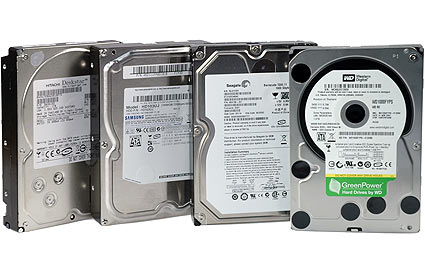Samsung Spinpoint F1 HDDs: New Winners?
Three Platter Design Beats The Competition
From left to right: the Hitachi Deskstar 7K1000, Samsung Spinpoint F1, Seagate Barracuda 7200.11 and Western Digital Caviar GP.
5, 4, 3... The first to ship a 3.5" hard drive with a one-terabyte capacity was Hitachi GST. The Deskstar 7K1000 has been shipping since April, and it reaches the total capacity utilizing a five-platter design. This way, it was possible for Hitachi to leverage mature technology (about 200 GB per platter) to create high-capacity drives. The upside of this decision was a quick time to market and decent performance; the downside is the increased number of moving parts, which raises power consumption, noise and heat dissipation.
Samsung and Seagate weren't second to the terabyte market, as announced earlier this year; rather it was Western Digital, with a radically changed product concept. The Caviar GP, which stands for Green Power, only operates at slightly more than 5,400 RPM, but cuts hard drive power consumption in half. Despite the lower speed it performs adequately, and the Caviar GP drives are now available as RAID Edition models that have been validated for 24/7 operation. Unlike Hitachi's five-platter Deskstar 7K1000, which is also available as a 24/7 Ultrastar A7K1000, the WD drives are based on only four platters. This is the foundation for the Caviar GP's higher data transfer rates; despite its lower rotation speed, the WD drive is not far behind its competitors.
The third and to date fastest 3.5" terabyte hard drive is Seagate's Barracuda 7200.11. It came later than expected, but it has also been the fastest 3.5" SATA drive thus far. It is also based on four platters, like the WD Caviar GP, but thanks to the full speed 7,200 RPM spindle, it breaks the 100 MB/s line. Its access time of only 12.7 ms is also the quickest of all four terabyte drives.
Samsung had announced that it wanted to pursue a three-platter design with its terabyte drive. While this was expected to deliver even higher data transfer rates, it would also enable the Korean mega-company to deliver single-platter hard drives at up to 320 GB. As a consequence, Samsung is now in a position to offer such a capacity with minimal material and production costs, while the other hard drive manufacturers cannot offer more than 250 GB on a single platter. These drives are largely uninteresting for enthusiasts, but they are crucial for business PCs, where due to purchase quantities, cost is a major issue.
If you now think that it could be easy for Samsung to put a fourth or maybe even a fifth platter into this design to create 1.2 and 1.5 TB hard drives, I have to disappoint you. While other hard drive families utilize platters that are 50 mil (thousandths of inches) thick, the Spinpoint F1 runs on 68 mil platters. For this reason, it's physically difficult to simply add a fourth platter to the stack. The thicker platters are used to increase resistance against vibration.
Get Tom's Hardware's best news and in-depth reviews, straight to your inbox.
Current page: Three Platter Design Beats The Competition
Prev Page Storage Developments Next Page Samsung Spinpoint F1 HD103UJ (1 TB)
Patrick Schmid was the editor-in-chief for Tom's Hardware from 2005 to 2006. He wrote numerous articles on a wide range of hardware topics, including storage, CPUs, and system builds.
-
evert Does anyone know what the differences (if any) are between the HD103UJ & HE103UJ models?Reply
-
HE=enterprise-class, raid certified. The only difference between HE and HD (in the specs) is a "rotational vibration sensor". Check them out on samsung.com.Reply
-
I have the famous spin ponit F1 which supossed to be compatible to sata 1 by switch or patch, @#$%^&* i can save files etc.......but it is impossible to install Windows!!!!!!!!!! And the technical support is @#$%^& no one answers. Just dont buy it!!!!!!!!!!Reply
-
bitage AnonymousI have the famous spin ponit F1 which supossed to be compatible to sata 1 by switch or patch, @#$%^&* i can save files etc.......but it is impossible to install Windows!!!!!!!!!! And the technical support is @#$%^& no one answers. Just dont buy it!!!!!!!!!!PEBKAC, all I have to say about that...Reply -
I bought one of these in march 2008, it's still going strong. Perhaps I don't hammer it with read/writes (it's a storage drive after all), but it gets used daily and has been in systems and in external cases, it's literally lived in as many different houses as I have; nearly 5 years later and it's still rock solid.Reply
(Was looking for pictures to use it creating an icon for it, ended up here in my stumbling, and thought I'd share my two cents.) -
TechMasterJoe Update i have a HD103UJ is has 55834 Powered on hours with 2119 starts still 100% G with zero errors and prefect SMART report still one of the coolest(temps) drives i own avg 26c with my WD's doing 36c + right next to iti use it as a temp dump for torrents before my custom software runs a ed2k hash on the file and files it way on my NAS in the 6.4years of UP time i have on this drive it has only been powered off for a few days at best wish any company made drives like this now days, under 200$ i used WD Reds for NAS but they all fail after 15k~20k hours.this has just been a friendly report from a long time Anime Sub Group's Encoder and archive owner.2014 home NAS Specs24X 4TB WD Reds NAS in custom U4 rack Quad E7-4870 & 256GB DDR3 (Folding@Home 99% of the time)2X Adaptec 2274900-R (future proof for expansion)ordered 12 more WD Reds this week yet to be added "amazon delivery Tuesday"Reply
